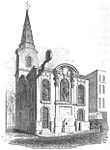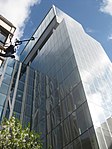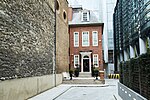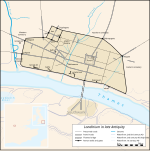London Stone
Grade II* listed buildings in the City of LondonGrade II* listed monuments and memorialsHistory of the City of LondonKilometre-zero markersLimestone ... and 5 more
Monuments and memorials in LondonMythological objectsStonesTourist attractions in the City of LondonUse British English from November 2014

London Stone is a historic landmark housed at 111 Cannon Street in the City of London. It is an irregular block of oolitic limestone measuring 53 × 43 × 30 cm (21 × 17 × 12"), the remnant of a once much larger object that had stood for many centuries on the south side of the street. The name "London Stone" was first recorded around the year 1100. The date and original purpose of the Stone are unknown, although it is possibly of Roman origin. There has been interest and speculation about it since the medieval period, but modern claims that it was formerly an object of veneration, or has some occult significance, are unsubstantiated.
Excerpt from the Wikipedia article London Stone (License: CC BY-SA 3.0, Authors, Images).London Stone
Salters' Hall Court, City of London
Geographical coordinates (GPS) Address Nearby Places Show on map
Geographical coordinates (GPS)
| Latitude | Longitude |
|---|---|
| N 51.5116 ° | E -0.0895 ° |
Address
O2
Salters' Hall Court
EC4N 8AH City of London
England, United Kingdom
Open on Google Maps











